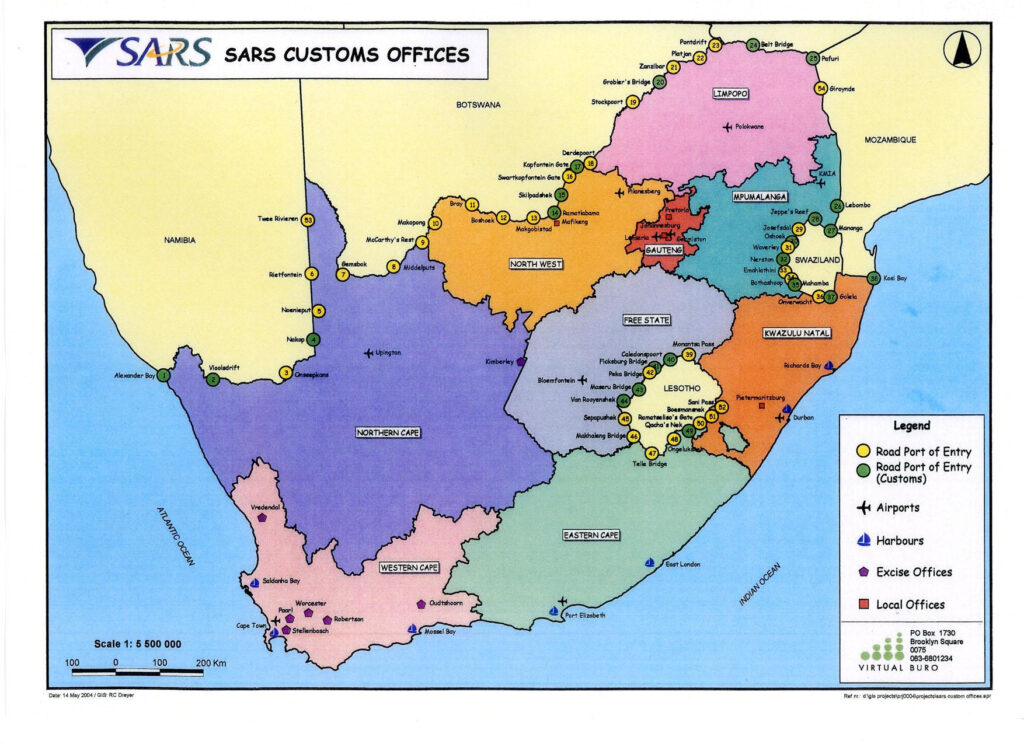Field of application notified
ATA Convention
Convention on « Professional equipment »
Convention on « Exhibitions and Fairs »
Convention on “Commercial Samples”
Istanbul Convention and its Annexes A and B1
The application of the ATA Carnet System covers the entire common Customs area, which means the combined areas of the Republic of South Africa, the Republic of Botswana, the Kingdom of Lesotho and the Kingdom of Swaziland and the Republic of Namibia (BLNS States).
Territorial coverage
The entire common Customs area, which means the combined areas of the Republic of South Africa, the Republic of Botswana, the Kingdom of Lesotho and the Kingdom of Swaziland and the Republic of Namibia.
Other applications
ATA Carnets are not accepted for postal traffic
ATA Carnets are accepted for transit in the case of non-accompanied good which because of their size and/or their nature must be forwarded from the Customs office of temporary importation to an international Customs office for checking purposes.
Languages in which Carnets should be completed
English. The Customs may require a translation when the ATA Carnets are completed in any other language. The translation is to be furnished by the importer or his agent.
Customs offices
All Customs offices are authorized to accept ATA Carnets during normal opening hours.
All hours during which Customs offices are open to the public. All Customs offices except those at international airports are closed on Saturdays and legal holidays.
Ports authorized to provide proofs of re-exportation on the ATA Carnets used in the South African Customs Union (SACU) countries, i.e. South Africa, Botswana, Lesotho, Namibia and Swaziland.
Please note that any of the Customs Offices on the attached map can be used. HOWEVER, for acquittal purposes (i.e. proof of re-exportation out of South Africa), only the listed border ports are valid (Annex overleaf refers)
This means for instance that one can have an entry stamp from Oshoek (# 30) and an exit stamp from Nerston (# 32). The Carnet holder is now somewhere in Mpumalanga, which is still within the common customs union (SACU) but is not an accepted border port for the re-exportation. Therefore, carnet holder must exit South Africa, through Lebombo (# 26) or through Johannesburg International Airport (JIA). From the map, you will note:
- Border ports numbers 1 – 6 and 53 goes into Namibia.
- To get from Namibia out of South Africa, you can utilize Walvisbay or Windhoek Airport, or any of the ports listed in Annex.
- Border ports numbers 7 – 23 goes into Botswana.
- To get from Botswana out of South Africa you can utilize Kazangula or any of the ports listed in Annex.
- Border ports numbers 39 to 52 goes into Lesotho.
- To get from Lesotho out of South Africa you can utilize any of the ports listed in Annex.
- Border ports numbers 27 –37 goes into Swaziland.
- To get from Swaziland out of South Africa, you can utilize any of the posts listed in Annex.
In the above analogy we have used the closest ports of exit, but any port on the list below, is valid.
This means that all numerated Customs offices apply, but for proof of reexportation, the following ports are deemed to be places of re-exportation:
- South African Border Posts
- Komatipoort
- Beitbridge
- South African Sea Ports
- Cape Town
- Port Elizabeth
- East London
- Durban
- Richards’ Bay
- South African International Airports
- Johannesburg International Airport
- Durban
- Cape Town
- Common Customs Union Border Ports
- Ramkogwebana
- Kazangula
- Wenela/Katimo Mulilo
- Oshikango
- Common Customs Union Sea Ports
- Walvisbay
- Common Customs Union Airports
- Windhoek

Was this helpful?
0 / 0